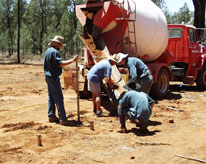
Termite chemicals degrade faster in soils

Some chemicals commonly used to protect timber from termites have been found to degrade at a faster rate than is presumed by Australian regulatory authorities.
NSW Department of Primary Industries forest and timber entomologist, Mr Martin Horwood, has found that a number of termiticides sprayed under or around timber structures degrade more rapidly in soils than is indicated by laboratory experiments.
A study by Mr Horwood published in the Australian Journal of Entomology (January 2007) examines degradation rates of five commonly used termiticides in soils 12 months after they were applied at two locations - Narrandera in inland NSW and Sydney.
The termiticides tested were chlorpyrifos, fipronil, imidacloprid, chlorfenapyr and bifenthrin.
He found levels of the first three chemicals found close to the surface of soils, when applied under field conditions according to the product label directions, were much lower than predicted 12 months after being applied.
“Chlorpyrifos experienced the most pronounced decline, virtually disappearing from the top 75 mm of soil at both test sites”, Mr Horwood said.
At Narrandera, fipronil and imidacloprid levels were also much lower than predicted.
In Sydney, the decline was more gradual.

Mr Horwood said temperature is known to be a factor in breakdown of insecticides.
“The chemicals in the laboratory experiments were protected from factors such as sunlight and high temperatures.
“However, it is likely that hotter temperatures at Narrandera may have contributed to the more rapid breakdown of these chemicals there.”
He said the laboratory studies normally relied upon to predict rates of breakdown were carried out in controlled environmental conditions including constant darkness and temperatures at or about 25 degrees C.
While the persistence of termiticides in the field has been studied extensively overseas, this is one of the first such studies to be undertaken in Australia. The findings are expected to have important implications for the regulation of termiticide application in Australia.
Mr Horwood said in recent years, regulatory agencies in several states have taken action against pest controllers for applying inadequate amounts of termiticide when doing termite applications.
“Soil samples have been taken and analysed. In some cases charges have been underpinned by expectations based on the results of laboratory data.”
He said the findings will help put efforts to regulate the pest control industry on a sounder footing.
“They should also help stop pest controllers who have done an honest job from being falsely accused of applying dosages that are too low.”
The Agricultural Pesticides and Veterinary Medicines Authority, which controls the registration of pesticides, and Standards Australia are being advised of the research findings. Standards Australia is currently reviewing the Australian termite control standards.
Email:

